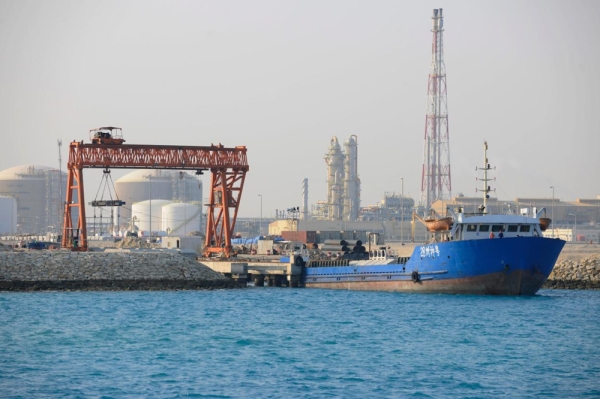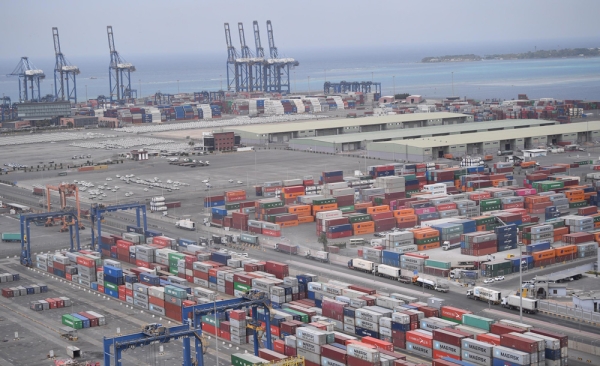


Maritime Transport in the Kingdomof Saudi Arabia is one of the logistic services sectors in the Kingdom, competent with transporting goods and passengers along the Kingdom’s coasts through internal and international sea voyages relying on multiple means of transport known as watercrafts, which differ from one another according to the roles assigned to them, operating under a maritime law that covers Saudi and foreign vessels docking at the Kingdom's ports or its territorial waters. Saudi commercial vessels are recognized by the Kingdom’s flag raised on board, which is a mandatory requirement for engaging in commercial maritime activities.
Maritime transport system in Saudi Arabia
The maritime transport sector in the Kingdom operates based on international navigation rules. Ports, harbors, and maritime lighthouses are the main hubs for sea communication in the Kingdom. These facilities are considered public rights and accessible for the public to engage in maritime activities, under applicable laws. No watercraft can leave maritime stations without registering all relevant information.
The Ministry of Transport and Logistic Services supervises the maritime transport sector in the Kingdom, sharing some responsibilities with the Saudi Ports Authority (Mawani). Their tasks include regulating maritime transport activities, ensuring the safe operation of facilities, providing budgets and resources, managing and developing technology for all forms of maritime transport, setting policies for maritime project development, and implementing international agreements related to maritime transport activities.
The geographical scope of maritime transport in Saudi Arabia
The Kingdom’s maritime transport covers a broad geographical scope with approximately 3,800 km of coastline. The maritime transport routes run from five administrative provinces overlooking water bodies in the Kingdom, including Tabuk, Makkah al-Mukarramah, Aseer, Jazan, and the Eastern Province, where ports and harbors are distributed along the coasts of these provinces.
The Kingdom has 1,285 islands spread across the Red Sea, the Gulf of Aqaba, and the Arabian Gulf. Among these, six islands are inhabited: Farasan al-Kabir, Sajid, and Qummah, part of the Farasan Archipelago in the Red Sea, and Islands of Tarut, Abu Ali, and Qunnah in the Arabian Gulf. These islands are inhabited hubs accessible via public ferry stations from major coastal cities.
In line with the development of the maritime transport sector, the vessels "Sara" and "Hessa" joined the Saudi maritime fleet in 2022, bringing the total number of national ships flying the Kingdom’s flag to 426, with a combined tonnage exceeding 13.5 million t. The number of Saudi sailors exceeds 2,100.
Economic significance of maritime transport
The extensive coastlines of the Kingdom have significantly contributed to the importance of maritime transport and its role in economic development, with waterways serving as critical and primary channels in global trade, connecting the three continents.
The Kingdom has thirteen ports along the Red Sea and the Arabian Gulf, including Jeddah Islamic Port, King Abdulaziz Port, King Abdullah Port, King Fahd Industrial Port in al-Jubayl, Yanbu Commercial Port, King Fahd Industrial Port in Yanbu, al-Jubayl Commercial Port, Jazan Port, Duba Port, Ras al-Khair Port, Ras Tannurah Port, al-Khafji Port, and Jazan Port for Primary and Downstream Industries. These ports handle 13 percent of global trade, facilitate 70 percent of the Kingdom’s imports, and manage 95 percent of its exports through 291 berths, with a capacity of 1.1 billion t and the ability to handle twenty million containers.
The Kingdom's maritime transport network is well-prepared for trade, travel, and leisure. It is worth mentioning that commercial maritime transport is the most active, as the Kingdom’s ports are closely connected to global markets due to their strategic location along international shipping routes. These ports handle one-third of the world’s oil shipments and approximately 13 percent of global trade annually, welcoming around 13,000 ships from the world each year.
Maritime transport systems in Saudi Arabia
Watercraft depart from and dock at a network of ports, harbors, and lighthouses designated for transporting goods and passengers. To possess a watercraft in the Kingdom, it is required to obtain a certificate from the Ministry of Transport that confirms the owner’s possession of the vessel and its seaworthiness in compliance with the ministry’s regulations. Each transport means is given a unique name chosen by its owner to distinguish it from others. These requirements apply to fishing boats, leisure boats, cranes, dredgers, and cargo ships.
Civilian maritime transport, limited to domestic and short-distance voyages, constitutes a maritime activity exempt from international commercial maritime transport laws and regulations. They use transport means restricted from sailing beyond the Kingdom’s maritime boundaries and are limited to ships under twenty-four m in length. This category also includes fishing boats with a capacity of less than thirty t and under twenty m in length, leisure and diving boats with a capacity of less than ten t and a length not exceeding eleven m, as well as primitively constructed ships, sailboats, non-self-propelled marine units, and floating structures operating within ports.
Maritime cruises and tourism
Domestic tourism along coastal areas has emerged as a key attraction in the Kingdom, with maritime transport no longer limited to trade and travel. Cruises have become a vital part of the tourism industry.
Beginning in 2020, the Kingdom introduced maritime cruises as part of the Saudi Summer program. These are coastal voyages on large, luxury cruise ships designed for leisure travel. The ships feature hotel rooms, restaurants, and entertainment areas, allowing tourists to enjoy a specific period of sailing while traveling between domestic and international destinations, along with tourist activities inside the ship on the open sea. The first cruise of this kind in the Kingdom departed from the port at King Abdullah Economic City in Rabigh City, located on the Red Sea coast, offering a journey to explore the pristine islands and marine life of the Kingdom.
Maritime Transport in the National Transport and Logistics Strategy
The maritime transport sector is a key component of the logistics services in the Kingdom, which plays a central role in achieving Saudi Vision 2030. The maritime logistics zones cover a vast area within the Kingdom and encompass a significant portion of the major projects under Saudi Vision 2030. These projects heavily rely on the development of infrastructure and the quality of marine life. As part of this, the Kingdom has announced the adoption of a new transport strategy known as the National Transport and Logistics Strategy, aimed at governing the port sector in the Kingdom. This involves introducing smart technologies, automating port networks, and upgrading maritime logistics infrastructure to increase port capacity to over forty million containers annually, strengthen connections with international shipping lines, and integrate with other logistics hubs across the Kingdom.
The development of maritime transport services has enhanced port performance, which resulted in the high international ranking of Saudi port networks. In 2022, the Kingdom's ports were ranked sixteenth globally in terms of cargo handling volumes in the Lloyd's List annual report. Furthermore, three Saudi ports were included in the list of the world's top one hundred ports: Jeddah Islamic Port, which ranked thirty-seventh globally; King Abdullah Port, ranked eighty-fourth; and King Abdulaziz Port, which ranked ninety-third.
Additionally, the Kingdom, represented by the Saudi Ports Authority (Mawani), made strides in the maritime network connectivity index in the fourth quarter 2023 report issued by UNCTAD, United Nations Conference on Trade and Development, achieving a score of 79.01 points. This progress supports the objectives of the National Transport and Logistics Strategy.
Several factors contributed to this achievement, including the addition of twenty-eight new shipping services in 2023 with major global shipping lines, qualitative advancements in container handling as recognized in the "2023 Lloyd's List" for container handling volumes among the world's top one hundred ports. The Kingdom advanced from twenty-fourth to sixteenth globally in container handling. Moreover, the Kingdom advanced seventeen places globally in the World Bank’s logistics index, reaching thirty-eighth out of 160 countries in international ranking in the Logistics Efficiency Index
Related quizzes
Related articles

